Apr 15, 2015 | cents, coins, commemorative, currency
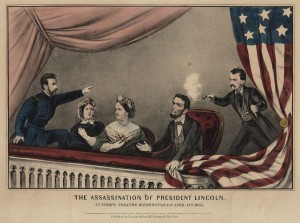
Lithograph depicting Lincoln’s Assassination by Currier and Ives.
Joining the crowd in the room was Surgeon General of the United States Army Joseph K. Barnes, his assistant Charles Henry Crane, Lincoln’s personal physician Dr. Robert K. Stone, and Dr. Anderson Ruffin Abbott the first Black Canadian to be a licensed physician. With Barnes in charge, the examination and treatment proved beyond the capabilities of the medical arts of the time. By 7:22 AM on April 15, 1865, Abraham Lincoln, the 16th President of the United States of America had succumbed to his injuries.
While every president faces their shares of challenges, Abraham Lincoln was challenged with the morality of slavery and the breaking apart of the republic before it reached its 100th anniversary. He was so concerned about keeping the nation together that not only did he have Union troops shoot at what he considered fellow Americans, but he broke laws and violated the constitution in order to keep the country going.
Lincoln is remembered for his debates with Stephen Douglas, the Emancipation Proclamation, Gettysburg Address, his second inaugural address, the Civil War, the Homestead Act, three revenue-based (taxation) acts, and the National Banking Act that lead to the creation of the Bureau of Engraving and Printing. Aside from being the first president assassinated, there are other aspects of his presidency that is not widely discussed. Lincoln was known for either not enforcing laws he did not like or over enforcing laws to silence critics. While he did not condone a lot of the brutality especially from Generals Sherman and Grant, he did not condemn them either. Some historians suggest that his appointment of the young General George B. McClellan after the loss at the First Battle of Bull Run was to use him to manipulate the strategy to be more brutal against the Confederacy.
In a move that would have had any modern president excoriated, Lincoln ignored a writ of habeas corpus issued by Supreme Court Chief Justice Roger B. Taney. Lincoln became incensed with Taney after he authored the controversial Dred Scott v. Sanford decision that Lincoln highly disagreed with. Following the writ, Lincoln and his cabinet ignored Taney, a move that hurt him in many ways. Taney died miserable and poor after a long illness blaming Lincoln for his decline.
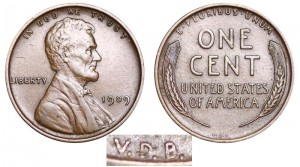
1909-VDB Lincoln Cent
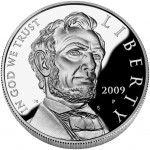
Obverse of the 2009 Abraham Lincoln Commemorative proof coin
At one time there was a trivia question as to the only United States coin with a presidential portrait of a president on both sides of the coin: the Lincoln Memorial cent. If you look carefully in the memorial on the reverse, you can see the statue of Lincoln in the memorial making it the only coin of its time to have this distinction.
Aside from appearing on the current $5 Federal Reserve Note, Lincoln has appeared on notes of 10 different designs and denominations including the fourth issue 50-cents fractional note, $10 Demand Note, $500 Gold Certificate, and a $1 large size silver certificate.

Series 1882 $500 Gold Certificate
In honor of Lincoln, spend at least one of those little copper-coated zinc cents remembering that if it was not for him, that coin might not have existed.
Curier & Ives image courtesy of the Smithsonian Institute.
Image of the 1909-VDB cent courtesy of
USAcoinbook.com.Image of the 2009 Lincoln commemorative dollar courtesy of the U.S. Mint.
Banknote image courtesy of
AntiqueBanknotes.com.
Apr 9, 2015 | BEP, currency, history, policy
NOTE: I am doing research into the policies that create our money. This is not a look into the economic policies but what happened after the economic policies are executed. For this series of articles, I wanted to know what happened after it was decided that the country would sell bonds in order to fund the Civil War. This is a summary of some of the research to answer one question and tie it in with history.
First of three parts.
Did you ever want to know how or why something was done but there was no answer? Or there may have been answers but nothing definitive that would make any of the answers true? It is this type of curiosity that had me searching for the answer to one question:
Why is the greenback green?
There are references that claim that the green printed back was to differentiate the currency of the United States from those from other countries. Other references call it an anti-counterfeiting mechanism. Neither claim can tie themselves to the actual events in such a way that we can say which is the truth. Or can we?
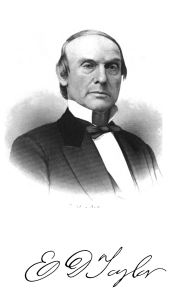
Col. Dick Taylor
Shortly after Taylor’s birth, the entire Taylor family moved to Kentucky because of exhausted lands in southern Virginia. They settled along the Ohio River outside of Louisville. In 1814, Giles moved his family Shawneetown, Illinois as one of the area’s pioneer settlers. Unfortunately, Giles died shortly thereafter leaving the family of little means.
Preferring to be called by his middle name, Taylor would be referred to by the common nickname of Dick and began travelling throughout the Midwest region to earn a living. At this time he would sign his name as “E.D. Taylor.” Dick Taylor demonstrated a lot of skill in organizing while operating as a trader on the frontier. By 1929, Taylor settled in Springfield, Illinois and married Margaret Taylor, the daughter of Col. Richard Taylor and sister of then Col. Zachary Taylor.
When the Black Hawk War broke out in 1831, he enlisted in the Illinois infantry and appointed as a colonel by the governor where he served with Jefferson Davis, General George Jones, and General Henry Dodge. Following the war he was elected to the Illinois House of Representatives then, after one term, was elected to the senate defeating a long-standing senator.
Taylor ran his senate campaign on a platform to move the capital from Vandalia to Springfield. To accomplish this, Taylor wrote a bill and worked with a representative named Abraham Lincoln, whom he met as a shopkeeper in New Salem. The bill was successful and Springfield has been the capital of Illinois since.
Taylor was a master at managing money and served the state in many capacities. In 1835, Taylor was appointed Receiver of Public Moneys in Chicago. Today, that position would be known at the comptroller. Under Taylor’s guidance, Chicago managed land sales better than any other city in the country and grew Chicago into the second largest city in the United States passing Philadelphia for that distinction. He was so well regarded in Washington, that not only did President Andrew Jackson hold a special dinner in Taylor’s honor, but appointed him to the commissions that oversaw the building of railroads in the upper Midwest.
With his connections from Springfield and working with Jackson, who is considered the father of the modern Democratic Party, Taylor became a member of the party and helped build the political machine that continues to run Chicago today. He was a friend and staunch supporter of Stephen A. Douglass and would travel the state stumping for Democratic candidates.
Taylor did not forget his friendship with Lincoln. Even though Lincoln had joined the then nascent Republican Party, he would also campaign with his friend in areas that were not strong Democratic strongholds. But for the presidential election of 1860, Taylor supported Douglas and campaigned throughout Illinois against Lincoln.
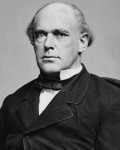
25th Secretary of the Treasury Salmon P. Chase
Knowing how Taylor turned around the finances of Chicago and then the railroad alliance, Lincoln turned to his old friend for advice. Taylor convinced Lincoln to ask congress to issue currency backed by the bonds but with no interest. Using what he learned in managing tickets sales for the railroads, Taylor provided Lincoln the outline for a currency system that was adopted with much reluctance by Chase.
First published in Abraham Lincoln, author Emil Ludwig found a letter acknowledging Taylor as the person who came up with the idea:
My dear Colonel Dick:
I have long determined to make public the origin of the greenback and tell the world that it was Dick Taylor’s creation. You had always been friendly to me. and when troublous times fell on us, and my shoulders, though broad and willing, were weak, and myself surrounded by such circumstances and such people that I knew not whom to trust, then I said in my extremity, ‘I will send for Colonel Taylor — he will know what to do.’ I think it was in January 1862, on or about the 16th, that I did so. Said you: ‘Why, issue treasury notes bearing no interest, printed on the best banking paper. Issue enough to pay off the army expenses and declare it legal tender.’ Chase thought it a hazardous thing, but we finally accomplished it, and gave the people of this Republic the greatest blessing they ever had — their own paper to pay their debts. It is due to you, the father of the present greenback, that the people should know it and I take great pleasure in making it known. How many times have I laughed at you telling me, plainly, that I was too lazy to be anything but a lawyer.
Yours Truly.
A. Lincoln
Lincoln, not one to miss an opportunity, used his executive authority to begin the production of a national paper currency in the form of Demand Notes as an extension of the Act of July 17, 1861 (12 Stat. 259) that authorized the printing of fractional currency.
Since the federal government did not have printing facilities, the law was written to allow notes to be produced by a “New York bank note company.” The first four issues fractional currency were printed by the American Banknote Company and the National Banknote Company. By the fifth issue, the new Bureau of Engraving and Printing began to print these notes.
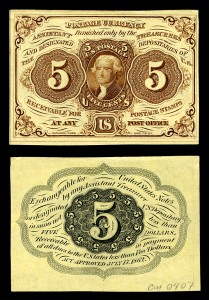
First issue: 5-cents, Thomas Jefferson (Fr. #1231)
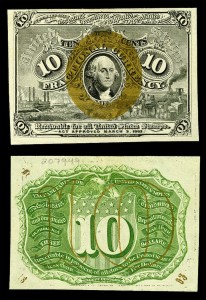
Second issue: 10-cents, George Washington (Fr. #1246)
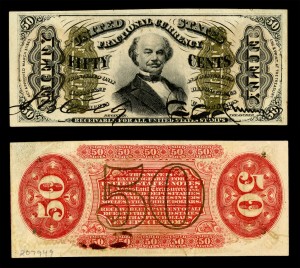
Third issue: 50-cents, Francis Spinner (Fr. #1328)
To save time and money, the first series of notes were printed four and six to a sheet in New York then shipped to Washington where the Treasury set up the Office of the Currency Comptroller to manage. As par of the OCC, the National Currency Bureau was created to do the cutting, bundling, and distribution of the currency.
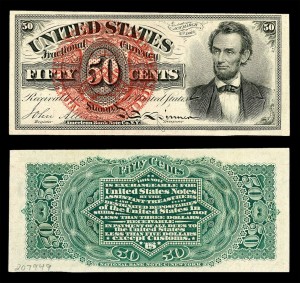
Fourth issue: 50-cents, Abraham Lincoln (Fr. #1374)
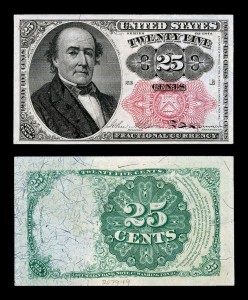
Fifth issue: 25-cents, Robert Walker (Fr. #1308)
The process for the United States to print its own currency had begun. While Secretary Chase was leading the plan to build a printing operation, congress authorized Treasury to establish an engraving and security printing bureau. That law was approved on July 11, 1862 (12 Stat. 532). With construction for a printing facility underway, Treasury hired James Duthie as the first engraver. Although he was a temporary engraver, he was provided a $1,600 per year salary (the equivalent to just under $38,000 in current dollars).
In Part 2 we introduce you to a little known geologist who may have developed more than the theory of the greenhouse effect.
References:
- Conrad, Howard Louis. “The Originator Of Greenback Currency: Colonel Edmund Dick Taylor.” The National Magazine, June 1892, 209-14.
- Ludwig, Emil, Eden and Cedar Paul (translators). Abraham Lincoln. Boston: Little, Brown, 1930.
- Mitchell, Wesley C. A History of the Greenbacks, with Special Reference to the Economic Consequences of Their Issue: 1862-65. Chicago: University of Chicago Press, 1903.
- History of the Bureau of Engraving and Printing, 1862-1962. Washington: Treasury Dept.; 1964.
- Gurney, G., & Gurney, C. (1978). The United States Treasury: A pictorial history. New York: Crown.
- Friedman, Morgan. “The Inflation Calculator.” Accessed April 7, 2015. http://www.westegg.com/inflation/.
Credits:
- Image of Col. E.D. Taylor from The National Magazine, June 1892.
- Image of Salmon P. Chase from the Library of Congress via Wikimedia Commons
- All fractional currency images courtesy of Wikimedia Commons
Feb 3, 2015 | BEP, coins, currency, Federal Reserve, policy, US Mint
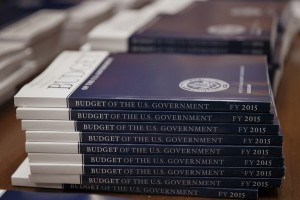 In celebration of a reoccurring activity but the government, on Groundhog Day the President released his Fiscal Year 2016 (FY16) budget request. Forgetting the usual politics surrounding congress’s reaction, the budget for numismatic-related production is largely irrelevant. Since 1950, the Bureau of Engraving and Printing has been funded using income from operations, mostly sale of currency to the Federal Reserve (Public Law 81–656, 31 U.S.C. § 5142). The United States Mint Public Enterprise Fund was established in 1996 to better manage the seigniorage earned from coin production (Public Law 104-52, 31 U.S.C. § 5136).
In celebration of a reoccurring activity but the government, on Groundhog Day the President released his Fiscal Year 2016 (FY16) budget request. Forgetting the usual politics surrounding congress’s reaction, the budget for numismatic-related production is largely irrelevant. Since 1950, the Bureau of Engraving and Printing has been funded using income from operations, mostly sale of currency to the Federal Reserve (Public Law 81–656, 31 U.S.C. § 5142). The United States Mint Public Enterprise Fund was established in 1996 to better manage the seigniorage earned from coin production (Public Law 104-52, 31 U.S.C. § 5136).
In short, both money production bureaus will be able to withdraw the money from their respective funds to fully support their operations.
Department of the Treasury requested that the BEP be allowed to withdraw $863 million for operations. The BEP have a total outlay of $918 million but will leverage $50 million from their current operating funds to make up the difference. Using projections from the previous years, the BEP anticipates an order for 8.3 billion notes or a 15-percent increase. Of the area that the BEP will be concentrating on includes additional research into anti-counterfeiting methods, make currency more accessible to the visually impaired, and modernizing the production process in Washington, D.C.
The budget does mention that the BEP was given legal authority to print currency for foreign countries with the approval of the State Department in 2005. However, the BEP has yet to be contracted by any country for this service. Many countries appear more interested in using the polymer substrate produced by the Reserve Bank of Australia than continuing to use cotton-fiber paper, which is favored in the United States.
Funding for the U.S. Mint is different in that while the Federal Reserve pays a fixed fee per currency note to the BEP, they pay face value for the coins they purchase from the U.S. Mint. Even though it costs more than face value to produce the one-cent and five-cent coins, the deficit is more than made up on the quarter dollar, the workhorse of the U.S. coin economy.
To fund its $3.59 billion operation, the U.S. Mint will be allowed to withdraw up to $20 million from their Public Enterprise Fund. That appropriation is only a cushion in case there is a shortfall in the anticipated $4.14 billion revenues. Although the U.S. Mint is now being run by Principal Deputy Director Rhett Jeppson, the organization is unlikely to reverse the production improvements implemented by former Deputy Director Richard Peterson.
One notable statement says, “The 2016 Budget includes a proposal to require the silver coins in United States Mint Silver Proof Sets to contain no less than 90 percent silver. Under current law, the half-dollar, quarter-dollar and dime coins in these sets “shall be made of an alloy of 90 percent silver and 10 percent copper.” Allowing the Mint to have flexibility in this composition will improve efficiency in the production process, lowering the costs for these products.” It appears that the U.S. Mint is asking congress to allow them to use another metal than copper while not changing the silver content. With the cost of copper rising to historic levels, using a less expensive metal on a coin that is not intended for circulation could be a cost savings.
While there will be political fireworks over other aspects of the president’s budget, those of us concerned with the money production by the Department of the Treasury can sit back and worry about other issues.
Jan 19, 2015 | BEP, counterfeit, currency, Federal Reserve
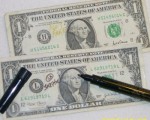
How an iodine pen reacts depends on the type of paper used.
As I was waiting to checkout, the person running the cash register was having difficulties with someone whose credit card was not being accepted. It did not matter what the problem was, the issue was holding up the line. While waiting, the gentleman next on line turned to me and said, “This is why I pay in cash.”
Apparently, my fellow line waiter and I had one thing in common, we both visited the bank prior to doing our shopping. He paid for his purchase with crisp, new currency. Just like my new currency, they were mostly $20 Federal Reserve Notes in serial number order fresh from a pack that was opened in the bank.
When the cashier counted the money, she picked up a pen and drew a line on each note. The pen was a counterfeit detection pen that contains an iodine-based ink used to determine whether the paper used is counterfeit.
These iodine pens test whether the paper is legitimate by checking if the iodine reacts with the starch that is used in commercial paper to make them look brighter. If the paper contains starch, then the ink turns dark indicating the paper is not real currency paper. Otherwise, the mark stays amber on the normal cotton bond paper.
There are two problems with this method of counterfeit detection. First, it is relatively easy to defeat the iodine pen by washing and bleaching a low denomination bill and reprinting a higher denomination on the same paper. By using legitimate currency paper, testing it with the iodine pen will not detect that it is counterfeit.
I remember there was a story on one of the television networks about how counterfeiters bleached $5 notes and passed them off as $20 notes after reprinting them. While searching, I found the following video of NBC’s Chris Hanson as he reported about this on Dateline:
Another problem with using iodine pens is that merchants that use them put their customers in danger who have iodine allergies. Those of us with severe iodine allergies can experience anaphylaxis, a serious reaction whose rapid onset can be so severe that it can cause death. As one of those people with severe iodine allergies, I watched this scene in horror.
Following a discussion with the manager, I consented to using a credit card since this was not one of those retailers that have been in the news for being hacked.
After all the Bureau of Engraving and Printing does to ensure that the new currency is more difficult to counterfeit and how the criminals are getting around these iodine pens by using real currency paper, it is incredible to think that these stores are still using tried but untrue measures for counterfeit detection.
In the meantime, the more serious counterfeiters are bleaching and overprinting $5 notes because as the criminal in the video says, nobody looks!
Jan 7, 2015 | BEP, currency, legislative, news
As congress convenes for its 114th session there are questions as to what the new Republican majority would do with their power. For numismatists waiting for congress to authorize the U.S. Mint to do anything, there may not be many changes from the last congress. Since financial bills are constitutionally required to start in the House of Representatives and since the House only increased its Republican majority, it is unlikely attitudes would significantly change. After all, in two years, the 113th congress passed only one commemorative coin bill.
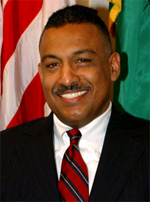
Larry R. Felix, the 24th Director of the Bureau of Engraving and Printing
Felix, who was born in Port of Spain, the capital of Trinidad and Tobago, was raised in New York City where he attended New York City College of Technology (City Tech) and City College of New York. He has been working for the BEP since 1993 and became the bureau’s director in 2006.
Felix was 24th director of the BEP and was the first African-American to be the Director.
Under Felix, the BEP introduced the next generation of currency designs in conjunction with the Federal Reserve and the U.S. Secret Service to make it more difficult to counterfeit U.S. currency including the new $100 Federal Reserve Note that has been recognized as the most difficult note to counterfeit. As part of the upgrade in production capabilities, Felix lead the BEP into a transition that made the bureau more technologically advanced and made their production more efficient.
Recent accomplishments include working with groups representing the visually impaired to make currency more accessible as part of a program called Meaningful Access. As part of that effort, the Meaningful Access program produced Eyenote for iOS and IDEAL Currency Identifier for Android to allow smartphone users to identify currency with their phone’s built in camera. They also are making iBill available for free to qualified visually impaired people. IBill is a pocket device that can be used to read U.S. currency and audibly identify its denomination that does not require a smartphone.
More recently, the BEP began to print one-dollar Federal Reserve Notes in sheets of 50 notes. During the production cycle, one-third of the notes being produced are $1 notes where more than 80-percent of the notes produced are used to replace worn currency. To meet the demand and lower the production cycle, this 38-percent per sheet increase in production will reduced the number of printing cycles required better meeting the demands of the BEP’s primary customer, the Federal Reserve.
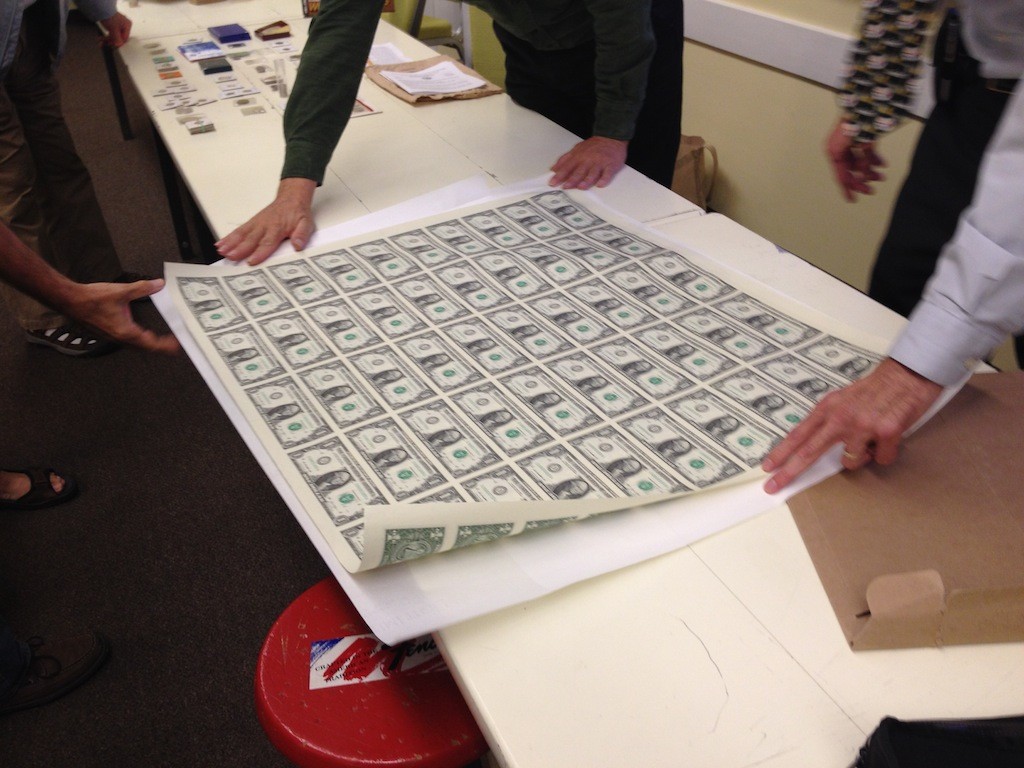
A view of the 50 Note Sheet of $1 Federal Reserve Notes.

BEP Deputy Director Len Olijar speaks to the Montgomery County Coin Club during their September 2014 meeting.
Unlike the U.S. Mint, the Director of the BEP is a career employee of the United States Government. BEP directors are members of the Senior Executive Service (SES), a program established as part of the Civil Service Reform Act of 1978 to “ensure that the executive management of the Government of the United States is responsive to the needs, policies, and goals of the Nation and otherwise is of the highest quality.”
Although most SES members are career employees, the government can hire qualified executives from outside of the government. These special appointments to the SES are renewable terms from three-to-five years where the appointee can only serve two appointments in the same position.
Since SES members are employees of the United States government, they are not subject to the Senatorial confirmation process political appointees must undergo. However, it is the job of the Secretary of the Treasury Jack Lew to appoint a new permanent director. It is likely Lew will make the appointment based on the recommendation of Treasurer Rosie Rios. Both Lew and Rios are political appointees whom have been confirmed by the Senate.
As an aside, the U.S. Mint has not had a director since the resignation of Edmund Moy in January 2011. Since the Director of the U.S. Mint is a politically appointed position, the U.S. Mint is legally managed by Treasurer Rosie Rios who has assigned Deputy Directory Richard A. Peterson to manage the day-to-day operations. Peterson, who is probably doing a better job than an appointee, is a career government employee and a member of the SES.
Image of Larry Felix courtesy of the Bureau of Engraving and Printing.
Dec 22, 2014 | BEP, cash, currency, Federal Reserve, video
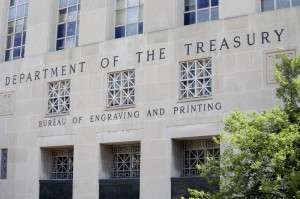 Last week, the Bureau of Engraving and Printing announced that the Federal Reserve had ordered the printing of 7.2 million Federal Reserve Notes for Fiscal Year 2015. This represents over $188 billion in currency.
Last week, the Bureau of Engraving and Printing announced that the Federal Reserve had ordered the printing of 7.2 million Federal Reserve Notes for Fiscal Year 2015. This represents over $188 billion in currency.
According to the Federal Reserve, the number of notes they order depends on the predicted growth in demand and the predicted number of notes that have to be destroyed because they are not usable any more. Both growth and demand are predicted to include world-wide usage of the United States Federal Reserve Note as it is the standard currency for many transaction. In addition to the demand and destruction is the predicted replacement of the old $100 Federal Reserve Note with the new note that has more advanced currency features. While the Federal Reserve will not recall the old $100 notes, they are removing them from circulation as they arrive back into the Federal Reserve system.
The following table is how the Federal Reserve says they broke down their order for 2015:
| Denomination |
Number of Notes |
Dollar Value |
| $1 |
2,451,200,000 |
$2,451,200,000 |
| $2 |
32,000,000 |
$64,000,000 |
| $5 |
755,200,000 |
$3,776,000,000 |
| $10 |
627,200,000 |
$6,272,000,000 |
| $20 |
1,868,800,000 |
$37,376,000,000 |
| $50 |
220,800,000 |
$11,040,000,000 |
| $100 |
1,276,800,000 |
$127,680,000,000 |
| Total |
7,232,000,000 |
$188,659,200,000 |
Included with the order are the notes that the Bureau of Engraving and Printing will sell to collectors. These are the same notes that collectors can purchase online at moneyfactorystore.gov and when the Bureau of Engraving and Printing attends shows.
As part of the announcement, the Federal Reserve released a video explaining how they decide the amount of currency to order.
[videojs mp4=”http://coinsblog.ws/library/videos/Question_4_FAQ_Video.mp4″ ogg=”http://coinsblog.ws/library/videos/Question_4_FAQ_Video.ogg” poster=”http://coinsblog.ws/library/videos/Question_4_FAQ_Video.jpg”]
Video courtesy of the Federal Reserve and the Bureau of Engraving and Printing
Oct 10, 2014 | coins, commentary, currency
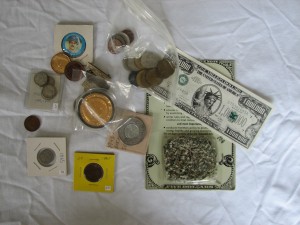 Collecting is a progressive addiction. It might start innocently with a friend introducing us to collecting and even giving us a few freebies. We dabble into buying more, especially items that tie us to our youth. We progress in collecting more from those childhood years putting together sets that we could not afford them. That feels pretty good, and soon we are tempted into expanding our collection into earlier and later years.
Collecting is a progressive addiction. It might start innocently with a friend introducing us to collecting and even giving us a few freebies. We dabble into buying more, especially items that tie us to our youth. We progress in collecting more from those childhood years putting together sets that we could not afford them. That feels pretty good, and soon we are tempted into expanding our collection into earlier and later years.
We get hooked on the high that comes from completing sets we only learned existed when we discover there are more cool items we never heard about before. We buy at flea markets, estate sales, from online classified advertisements, auctions, and dealers in cramped stores. Eventually, we are completely addicted and start bidding furiously on everything related to our collection including items in better condition than what we already have.
The collectors’ eyes start to glaze over as they move into progressive rounds of the addiction. Related collectibles appear on den and basement shelves. Second and third sets accumulate. Family members enable the addicts by covering up for them when they miss family events to visit yard sales or dealers instead. Soon the addicts are looking for obscure pieces and those one-of-a-kind items desired only by the select few who are as addicted.
This was adapted from a section in the article “
Baseball Cards: You Can’t Collect Everything, Right?.” When I read this in the section with the title “The signs of addiction” it was something that had to be applied to collecting in general. It is something to think about as we begin a three-day weekend!
Oct 7, 2014 | BEP, coins, counterfeit, currency, gold, policy, US Mint
Prior to the public disclosure of secret documents, administrations have declassified documents at various levels for many different reasons that those of us who worked in these areas did not understand what was to be classified at what levels and for how long. Each department and agency had its own rule. However, everything that was classified was supposed to be declassified after 50 years.
In 2009, President Obama issued Executive Order 13526 to try to create some order out of this chaos. Aside from defining the classification levels, document marking requirements, it also allowed agencies to apply to keep documents classified and for longer periods than previous reviews. The purpose was to protect national interests and security while preventing controversial declassification of documents.
Whenever trying to instill a new policy on the government, there will be many barriers to this change. While there are fewer areas of confusion, chaos remains. Of course the disclosures by Chelsea (neé Bradley) Manning and Edward Snowden did not help.
So what does this have to do with numismatics? Both the U.S. Mint and the Bureau of Engraving and Printing applied and were granted exemption from automatically declassifying documents.
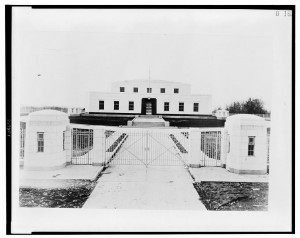
Treasury Department, Procurement Division, Public Buildings Branch, Fort Knox – United States Bullion Depository (1939)
What information could these agencies possibly have that would be classified?
According to Steven Aftergood, Director of the Federation of American Scientist Project on Government Secrecy, who interviewed John P. Fitzpatrick, director of the ISOO, the exemption for the U.S. Mint is for “security specifications from the U.S. Bullion Depository at Fort Knox, which was built in the late 1930s.”
In a comedic turn, Mr. Fitzpatrick told Aftergood, “Think ‘Goldfinger’.”
Then why does the Bureau of Engraving and Printing need an exemption from declassification for 25-years? A source familiar with the filing said that the exemption covers counterfeiting information. According to sources, there are anti-counterfeiting measures added to currency that have been planned for many years that have not been advertised. These are used by the United States Secret Service and other law enforcement organizations to detect counterfeiting. Many of the documents cover the planning for the changes that began in the 1990s.
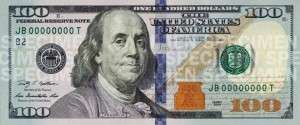 Sources also confirmed that there were other documents that the BEP and Treasury asked to be included in this exemption but not their general contents. Some hint was given that the classified information concerns long term and ongoing operations against international counterfeiters. Although not confirmed, it is suspected that the classified documents discusses enemy foreign governments actively working to counterfeit United States currency. No country was named but it has been rumored that North Korea has been attempting to counterfeit U.S. currency.
Sources also confirmed that there were other documents that the BEP and Treasury asked to be included in this exemption but not their general contents. Some hint was given that the classified information concerns long term and ongoing operations against international counterfeiters. Although not confirmed, it is suspected that the classified documents discusses enemy foreign governments actively working to counterfeit United States currency. No country was named but it has been rumored that North Korea has been attempting to counterfeit U.S. currency.
And you thought all the U.S. Mint and Bureau of Engraving and Printing did was manufacture money!
Aug 3, 2014 | BEP, coins, currency, Federal Reserve, US Mint
While doing my monthly review of the numismatic-related political news for the Gold & Silver Political Action Committee, I came across a bill that seems to have missed the numismatic press. One reason it was missed might be that the provisions are buried in a larger bill and has a name that might not be as noticeable. However, there are two issues buried in a larger bill. The bill is as follows:
H.R. 5196: Unified Savings and Accountability Act (or USA Act)
Sponsor: Rep. Mike Coffman (R-CO)
• To reduce waste and implement cost savings and revenue enhancement for the Federal Government.
• Introduced: July 24, 2014
• Referred to several committees based on jurisdiction of the provision.
Track this bill at https://www.govtrack.us/congress/bills/113/hr5196
Buried within the bill are two provision that may be of interest to collectors.
Sec. 203. Prohibition on non-cost-effective minting and printing of coins and currency.
If passed, Section 203 would require that the U.S. Mint stop striking any coin that costs more to manufacture than its face value four years following the passage of this bill. Using current standards, the U.S. Mint would be required to stop producing one- and five-cent coins by late 2018 because they cost more than their face value to produce. One of the problems with this bill is what would happen if the price of copper and zinc, the drivers in the price of both coins, were to fall and the costs were reduced to below face value? Would the coins be struck again?
Sec. 205. Replacing the $1 note with the $1 coin.
As the title suggests, Section 205 will replace the one-dollar Federal Reserve Note with the dollar coin. The section begins with requiring the Federal Reserve to “sequester” Susan B. Anthony dollars to remove them from circulation. There is a provision for their value as numismatic collectibles.
The plan to remove the $1 FRN is just to stop issuing the notes and replace them with coins as the notes come out of circulation after a one-year educational period. The Federal Reserve would continue to use the notes alongside the coins until 600 million coins are in circulation or for four years, whichever comes first. The bill allows the Bureau of Engraving and Printing to continue to print the $1 FRN for collectors.
Given the current state of congress, the likelihood of this bill passing is slim-to-none, and, as a friend liked to say, “Slim just left town.” Some of the other provisions of this bill might be introduced into an omnibus budget bill following the November elections, but it is doubtful that these sections will make it past this introduction.
Then again, who knows? Congress has surprised us in the past!
Jul 4, 2014 | coins, currency, history
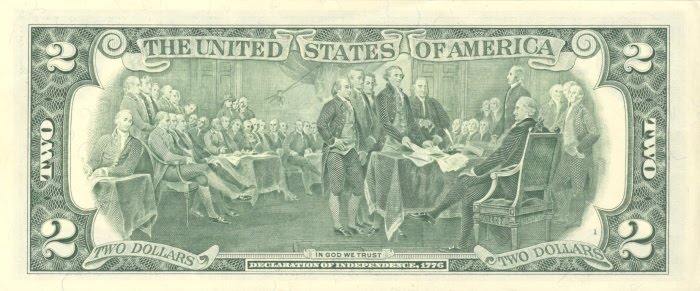
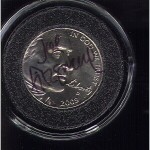 The Continental Congress met on July 1, 1776 to take up the resolution of Richard Henry Lee, a delegate from Virginia. Lee had brought with him a resolution from the Virginia Convention to “propose to that respectable body to declare the United Colonies free and independent states” that was first heard on June 7, 1776. The July 1 meeting was the culmination of the resolution being documented by John Adams (Massachusetts), Roger Sherman (Connecticut), Benjamin Franklin (Pennsylvania), Robert R. Livingston (New York), and Thomas Jefferson (Virginia). Although the document went through some editing by Franklin and Adams, it was still Jefferson’s words that rang forth:
The Continental Congress met on July 1, 1776 to take up the resolution of Richard Henry Lee, a delegate from Virginia. Lee had brought with him a resolution from the Virginia Convention to “propose to that respectable body to declare the United Colonies free and independent states” that was first heard on June 7, 1776. The July 1 meeting was the culmination of the resolution being documented by John Adams (Massachusetts), Roger Sherman (Connecticut), Benjamin Franklin (Pennsylvania), Robert R. Livingston (New York), and Thomas Jefferson (Virginia). Although the document went through some editing by Franklin and Adams, it was still Jefferson’s words that rang forth:
When in the Course of human events, it becomes necessary for one people to dissolve the political bands which have connected them with another, and to assume among the powers of the earth, the separate and equal station to which the Laws of Nature and of Nature’s God entitle them, a decent respect to the opinions of mankind requires that they should declare the causes which impel them to the separation.
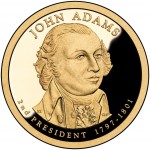 Asserting their right of freedom from the “the establishment of an absolute Tyranny over these States” was a bold move of this body. One that could land every one of them in jail, ruined, tortured, or dead. But these men, some of great means, risked everything and pursued a path of freedom and justice.
Asserting their right of freedom from the “the establishment of an absolute Tyranny over these States” was a bold move of this body. One that could land every one of them in jail, ruined, tortured, or dead. But these men, some of great means, risked everything and pursued a path of freedom and justice.
We hold these truths to be self-evident, that all men are created equal, that they are endowed by their Creator with certain unalienable Rights, that among these are Life, Liberty and the pursuit of Happiness.—That to secure these rights, Governments are instituted among Men, deriving their just powers from the consent of the governed,—That whenever any Form of Government becomes destructive of these ends, it is the Right of the People to alter or to abolish it, and to institute new Government, laying its foundation on such principles and organizing its powers in such form, as to them shall seem most likely to effect their Safety and Happiness. Prudence, indeed, will dictate that Governments long established should not be changed for light and transient causes; and accordingly all experience hath shewn, that mankind are more disposed to suffer, while evils are sufferable, than to right themselves by abolishing the forms to which they are accustomed. But when a long train of abuses and usurpations, pursuing invariably the same Object evinces a design to reduce them under absolute Despotism, it is their right, it is their duty, to throw off such Government, and to provide new Guards for their future security.
Accusing the King of crimes against the colonies and using his whim, and not laws, to rule the colonies was as immoral as it was illegal. Taxation without representation, the right to govern oneself, housing militia without permission, restricting trade, and suspending trial by jury were some of the accusations levied against the crown.
In every stage of these Oppressions We have Petitioned for Redress in the most humble terms: Our repeated Petitions have been answered only by repeated injury. A Prince whose character is thus marked by every act which may define a Tyrant, is unfit to be the ruler of a free people.
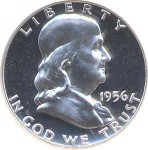 Even as Benjamin Franklin sought to try to negotiate with the King and his representatives, Franklin toiled with the Continentals as he saw that the King’s court was not negotiating in good faith.
Even as Benjamin Franklin sought to try to negotiate with the King and his representatives, Franklin toiled with the Continentals as he saw that the King’s court was not negotiating in good faith.
Nor have We been wanting in attentions to our Brittish brethren. We have warned them from time to time of attempts by their legislature to extend an unwarrantable jurisdiction over us. We have reminded them of the circumstances of our emigration and settlement here. We have appealed to their native justice and magnanimity, and we have conjured them by the ties of our common kindred to disavow these usurpations, which, would inevitably interrupt our connections and correspondence. They too have been deaf to the voice of justice and of consanguinity. We must, therefore, acquiesce in the necessity, which denounces our Separation, and hold them, as we hold the rest of mankind, Enemies in War, in Peace Friends.
With a final unanimous vote, Richard Henry Lee’s resolution was passed on July 4, 1776. Copies were engrossed over night and formally signed on July 5, 1776 before being dispatched to the colonies.
We, therefore, the Representatives of the united States of America, in General Congress, Assembled, appealing to the Supreme Judge of the world for the rectitude of our intentions, do, in the Name, and by Authority of the good People of these Colonies, solemnly publish and declare, That these United Colonies are, and of Right ought to be Free and Independent States; that they are Absolved from all Allegiance to the British Crown, and that all political connection between them and the State of Great Britain, is and ought to be totally dissolved; and that as Free and Independent States, they have full Power to levy War, conclude Peace, contract Alliances, establish Commerce, and to do all other Acts and Things which Independent States may of right do. And for the support of this Declaration, with a firm reliance on the protection of divine Providence, we mutually pledge to each other our Lives, our Fortunes and our sacred Honor.

On this, the 238 anniversary of the signing of the Declaration of Independence, may you revel in the accomplishment and pray for peace in our time.
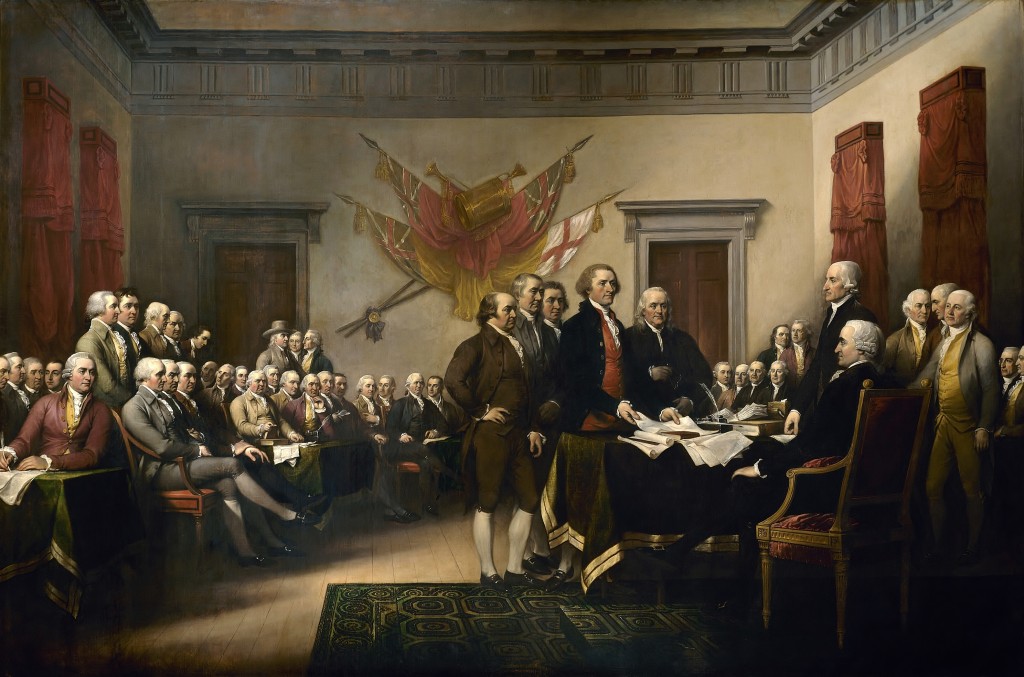
John Trumbull’s Declaration of Independence hangs in the U.S. Capitol Rotunda. It was used as the model for the reverse of the $2 Federal Reserve Note.
Image of the Joe Fitzgerald autographed 2005 Jefferson Nickel is property of the author.
John Adams $1 coin image courtesy of the U.S. Mint.
All other images courtesy of Wikimedia Commons.
















 Last week, the
Last week, the  Collecting is a progressive addiction. It might start innocently with a friend introducing us to collecting and even giving us a few freebies. We dabble into buying more, especially items that tie us to our youth. We progress in collecting more from those childhood years putting together sets that we could not afford them. That feels pretty good, and soon we are tempted into expanding our collection into earlier and later years.
Collecting is a progressive addiction. It might start innocently with a friend introducing us to collecting and even giving us a few freebies. We dabble into buying more, especially items that tie us to our youth. We progress in collecting more from those childhood years putting together sets that we could not afford them. That feels pretty good, and soon we are tempted into expanding our collection into earlier and later years.







